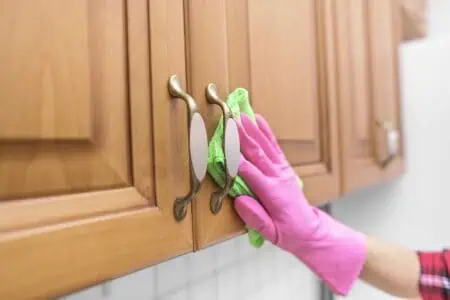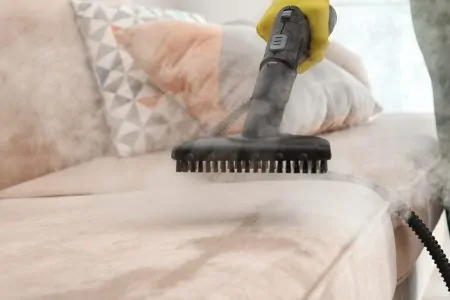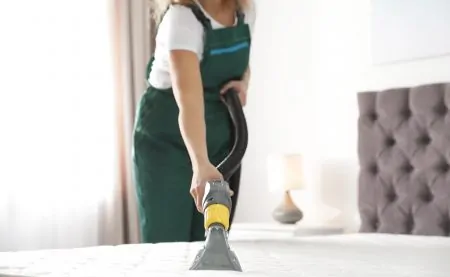Thrifting furniture is a total joy: you can find beautiful pieces for impressive prices. But often, the pieces need a little bit of tender love and care. If you have wood furniture that smells stinky, musty, or moldy, that’s normal and not a massive cause for concern.
But you still want to know how to get smells out of wood furniture. We have super handy tips for removing these odors using 10 different methods.
Before you know it, your wooden furniture will smell as good as new.
Key Takeaways
- Air out wood furniture for 12 hours before cleaning it with a 1:1 solution of distilled white vinegar and water.
- Use alternative methods like dryer sheets, baking soda, or Murphy’s Oil if vinegar doesn’t remove the odor.
- For stubborn smells, consider sanding and sealing the wood furniture to eliminate trapped odors.
- Keep drawers smelling fresh with scented drawer liners, essential oils, or bars of soap.
How To Get Smells Out of Wood Furniture
The first method you want to try is airing out the wood and cleaning it with vinegar. This is the most effective and easiest method for general smells. It can also kill mold and mildew.
- Time: 30 minutes (plus waiting time).
- Difficulty: Easy.
What You’ll Need
- Distilled white vinegar.
- Containers.
- Water.
- Spray bottle (optional).
- Microfiber cloths.
1. Air the Furniture Out
Take the furniture to a breezy spot — such as your garden or near a window — to air out. Give it as long as possible to air out; around 12 hours is best.
Make sure it’s not a rainy or humid day, as this can lead to moisture issues within the wood.
2. Clean With Vinegar
Vinegar can remove odors from wooden furniture. The easiest way to clean wood with vinegar is by filling a spray bottle with a 1:1 vinegar and water solution. Spritz the wood with the solution and wipe well with a microfiber cloth.
If you don’t have a spray bottle, fill a bowl with a 1:1 solution of vinegar and water. Dampen a microfiber cloth in the solution and wipe down every area of the wood.
3. Dry the Wood
Take a separate microfiber cloth and soak up wet vinegar residue from the wood.
4. Set Up Vinegar Bowls
Vinegar can also absorb odors. So if you have any remaining odors after step two, try this.
Fill up a few containers with distilled white vinegar. Place them around or inside the wooden furniture. If you are trying to deodorize drawers, place one container of vinegar inside each drawer.
Leave the vinegar bowls for 24 hours to absorb all odors. Then discard the vinegar and wash the bowls out thoroughly.
How To Get Tough Smells Out of Wood Furniture
If the odors aren’t disappearing with the vinegar trick, you may have some stubborn and tough odors. If you’ve had a spill, the furniture is really old, or the smells are just lingering — you should try another odor remover.
We have nine extra methods to try. These all work wonderfully for removing odors. Give one a go, and if that doesn’t work, try a few other hacks until your wooden furniture is stink-free.
With Dryer Sheets
This method works great for lingering odors or odors that keep coming back. Simply line the wooden furniture with dryer sheets. If you have a dresser or a trunk, stash dryer sheets inside.
Leave them in or on the furniture for 24 hours. You can also leave them there long-term to combat odors as they happen. Just swap them out for new dryer sheets every few weeks.
With Baking Soda
Fill a bowl or container with baking soda and pop it inside the furniture. This works best with drawers or trunks rather than tables or chairs. However, if you have wooden tables or chairs, you can place the baking soda nearby, which should absorb some of the smell.
Leave the baking soda inside for a couple of days and swap it out for new baking soda. Repeat this process for one week. The baking soda will absorb excess smells.
With Murphy’s Oil
Murphy’s Oil soap wood cleaner is a super popular and effective product for cleaning all types of wood, including finished and unfinished.
To use, follow these instructions:
- Dilute: Dilute ½ cup of Murphy’s Oil per gallon of water.
- Apply: Apply the solution to the furniture using a microfiber cloth. Dampen the whole cloth, wring it out well, and wipe the wood.
- Wipe: With a separate cloth, wipe away the excess. There’s no need to rinse Murphy’s Oil!
With Vodka
Vodka can help to neutralize odors. Simply fill a spray bottle with vodka and mist the wood, inside and out. Leave the piece in a breezy or sunny spot to completely air dry.
By Sanding and Sealing
If nothing else works, you might have to remove the odors by sanding the furniture back to its roots. This can air out the wood pores and release bad odors. Just note that after sanding the wood back, you will need to reseal it.
This method is fantastic for tough odors like cigarette smoke.
Here’s how to remove odors from wood furniture by sanding and sealing:
- Prepare your workspace: Make sure to work in a well-ventilated area and wear a face mask, safety glasses, and protective gloves.
- Wash the wood: Wash the wood with soapy water and a cloth.
- Dry the wood: Dry the wood with a separate cloth.
- Apply stain remover: Most wooden pieces will have a stain finish. If yours has this, grab a wood stain remover, such as Minwax Antique Furniture Refinisher. Read the instructions carefully. Generally, you will shake the product and pour it into a metal or glass container. Apply the stain remover in thick, even layers with a natural bristle paintbrush. For bigger pieces, work on one small area at a time.
- Wait: Leave the stain remover on for the recommended time — usually 30 minutes.
- Scrape: When the time is up, or the stain remover starts bubbling, scrape it off with a putty knife or plastic scraper. Discard this into the trash. Then scrape the excess off with steel wool, moving in the direction of the wood grain.
- Remove excess: Dampen a cloth and wipe the wood to remove excess.
- Wait: Give the wood at least 24 hours to dry out thoroughly.
- Sand: Now it’s time to sand the wood. Start with a low grit sandpaper, around 100. Gently sand the wood to remove excess paint stripper. Wipe the loosened residue away with a cloth. Then move up to 180-grit sandpaper, working in the direction of the grain until the wood is smooth.
- Vacuum: Use a handheld vacuum cleaner to remove excess dust.
- Air it out: Leave the wood in a breezy spot to air out for 12 hours. This will help to remove trapped odors. If the wood still stinks after 12 hours, leave it to air out until it is no longer smelly.
- Wipe: Once the wood has aired out, dampen a cloth with water or mineral spirits and wipe the wood in the direction of the grain.
- Apply sealer: Apply your chosen sealer with a clean brush, quickly moving along the grain. Make sure to evenly cover the wood, taking special note of the end grain. If the end grain isn’t sealed correctly, it will absorb more stains and odors.
- Wait: Leave the sealer to dry completely. This can take a few hours, depending on the product you choose.
- Sand: Lightly sand the furniture with fine-grit sandpaper, around 220 or higher. This will smooth out the wood without removing the seal. Wipe the sanding residue with a cloth.
- Repeat: If necessary, add another layer of sealer. This might be necessary for certain products or if the sealer hasn’t protected all the wood pores.
With Other Deodorizers
While the above methods are super effective and should do the trick, there are some other things you can try. This is particularly useful if you don’t have the above products in the house.
- Kitty Litter: Place a container of kitty litter in or nearby the wooden furniture. Leave it for 24 hours to absorb the odors.
- Coffee Grounds: Place used coffee grounds in containers and put them in or nearby the wooden furniture. Leave for 24 hours — the coffee will absorb the odors. Make sure to discard the coffee grounds after 24 hours, or they can quickly become moldy.
- Charcoal: Charcoal is naturally absorbent. You can use leftover charcoal from your grill or charcoal bags. Place the charcoal pieces in a bowl and put it in or near the wooden furniture. If using bags, pop them inside the furniture or nearby. Leave it overnight.
- Newspaper: Wad up newspaper and put the balls inside the wooden furniture. This only works for furniture you can place things inside of, like a desk or chest of drawers. Close the drawers and leave the newspaper in for a few days so it can absorb the odors. This works best for mild odors only.
What Can I Put In My Drawers To Make Them Smell Nice?
Removing odors from your wooden furniture is a good skill to have. But you might want to do something between deep cleans to ensure your wooden furniture has a pleasant scent. This can help to combat musty and old smells.
You have a few options:
- Use dryer sheets: As mentioned, you can put dryer sheets in your drawers to keep the area smelling fresh. After going through a load of laundry, don’t toss your dryer sheets away — just pop them in your drawers.
- Drawer sachets: Drawer sachets can keep your drawers smelling fresh. Some can also protect against moths. However, if you have regular moth and beetle issues, you may want to use mothballs.
- Scented drawer liners: Many people like to line drawers for aesthetic and protection purposes. But you can also get scented drawer liners which will leave a beautiful perfume in your drawers and on your clothes.
- Essential oils: Pop 10 drops of essential oil on a washcloth and place it in your drawers. This will leave behind a fresh aroma.
- Bar of soap: Wrap a bar of scented soap in a paper towel and place it in your drawers. This will provide long-lasting freshness.
FAQs
Fresh Wood Furniture
When you bring home a stinky piece of wood furniture, don’t worry. Whether the wood furniture is new or old, air it for 12 hours. Then clean it using our vinegar method.
If that doesn’t work, you can try Murphy Oil, baking soda, dryer sheets, or another one of our amazing hacks.
If odors remain, you might need to sand the piece back, air it out and reseal. This is especially true for vintage or thrifted pieces since the odors might be trapped deep within the wood pores.
Note that these methods aren’t suitable for rotten wood — you will need to repair the furniture rather than just remove odors.











